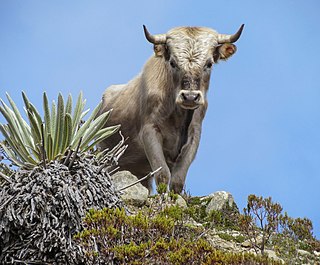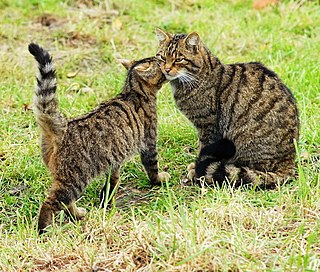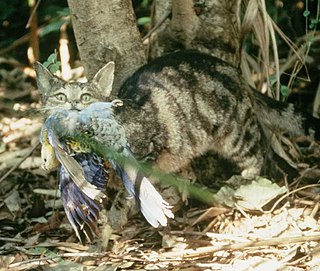Related Research Articles

Leadbeater's possum is a critically endangered possum largely restricted to small pockets of alpine ash, mountain ash, and snow gum forests in the Central Highlands of Victoria, Australia, north-east of Melbourne. It is primitive, relict, and non-gliding, and, as the only species in the petaurid genus Gymnobelideus, represents an ancestral form. Formerly, Leadbeater's possums were moderately common within the very small areas they inhabited; their requirement for year-round food supplies and tree-holes to take refuge in during the day restricts them to mixed-age wet sclerophyll forest with a dense mid-story of Acacia. The species was named in 1867 after John Leadbeater, the then taxidermist at the Museum Victoria. They also go by the common name of fairy possum. On 2 March 1971, the State of Victoria made the Leadbeater's possum its faunal emblem.

A feral animal or plant is one that lives in the wild but is descended from domesticated individuals. As with an introduced species, the introduction of feral animals or plants to non-native regions may disrupt ecosystems and has, in some cases, contributed to extinction of indigenous species. The removal of feral species is a major focus of island restoration.
Trap–neuter–return (TNR), also known as trap–neuter–release, is a controversial method that attempts to manage populations of feral domestic cats. The process involves live-trapping the cats, having them spayed or neutered, ear-tipped for identification and, if possible, vaccinated, then releasing them back into the outdoors. If the location is deemed unsafe or otherwise inappropriate, the cats may be relocated to other appropriate areas. Ideally, friendly adults and kittens young enough to be easily socialized are retained and placed for adoption. Feral cats cannot be socialized, shun most human interaction and do not fare well in confinement, so they are not retained. Cats suffering from severe medical problems such as terminal, contagious, or untreatable illnesses or injuries are often euthanized.
The British Birdwatching Fair or Birdfair is an annual event for birdwatchers, held every August at Rutland Water in England, run by staff and volunteers from the Leicestershire and Rutland Wildlife Trust. The last two birdfairs have been cancelled due to the COVID-19 pandemic and in November 2021 it was permanently cancelled over financial concerns.

A feral cat or a stray cat is an unowned domestic cat that lives outdoors and avoids human contact: it does not allow itself to be handled or touched, and usually remains hidden from humans. Feral cats may breed over dozens of generations and become an aggressive local apex predator in urban, savannah and bushland environments. Some feral cats may become more comfortable with people who regularly feed them, but even with long-term attempts at socialization, they usually remain aloof and are most active after dusk.

The eastern barred bandicoot is a nocturnal, rabbit-sized marsupial endemic to southeastern Australia, being native to the island of Tasmania and mainland Victoria. It is one of three surviving bandicoot species in the genus Perameles. It is distinguishable from its partially-sympatric congener – the long-nosed bandicoot – via three or four dark horizontal bars found on its rump. It is the only species of bandicoot found on Tasmania, where it is relatively abundant. The mainland population in Victoria is struggling and is subject to ongoing conservation endeavors.

Buglife – The Invertebrate Conservation Trust is a British-based nature conservation charity.

The European wildcat is a small wildcat species native to continental Europe, Scotland, Turkey and the Caucasus. It inhabits forests from the Iberian Peninsula, Italy, Central and Eastern Europe to the Caucasus. Its fur is brownish to grey with stripes on the forehead and on the sides and has a bushy tail with a black tip. It reaches a head-to-body length of up to 65 cm (26 in) with a 34.5 cm long tail, and weighs up to 7.5 kg (17 lb).

The fauna of Scotland is generally typical of the northwest European part of the Palearctic realm, although several of the country's larger mammals were hunted to extinction in historic times and human activity has also led to various species of wildlife being introduced. Scotland's diverse temperate environments support 62 species of wild mammals, including a population of wild cats, important numbers of grey and harbour seals and the most northerly colony of bottlenose dolphins in the world.

Carna or Càrna is an island in Loch Sunart, an arm of the sea, close to the Ardnamurchan peninsula, on the west coast of Scotland.

A frozen zoo is a storage facility in which genetic materials taken from animals are stored at very low temperatures (−196 °C) in tanks of liquid nitrogen. Material preserved in this way can be stored indefinitely and used for artificial insemination, in vitro fertilisation, embryo transfer, and cloning. Some facilities also collect and cryopreserve plant material.
Alley Cat Rescue is an organization in Mount Rainier, Maryland, that works to protect cats through rescue, rehabilitation and adoption locally in the states of California, Maryland, Virginia, and the Washington, D.C., area using trap-neuter-return for feral cats; as well as providing national and international resources for cat caretakers.

Saving Planet Earth is a season of nature documentaries with a conservation theme, screened on BBC Television in 2007 to mark the 50th anniversary of its specialist factual department, the BBC Natural History Unit.
Alley Cat Allies is a nonprofit animal welfare organisation. It advocates for reform of public policies and institutions to better serve the interests of cats. Based in Bethesda, Maryland, the group is best known for introducing trap-neuter-return to the United States.

The Scottish wildcat is a European wildcat population in Scotland. It is estimated to comprise between 1,000 and 4,000 individuals, of which about 400 cats are thought to meet the morphological and genetic criteria of a wildcat. The Scottish wildcat was once widely distributed across Great Britain, but the population has declined drastically since the turn of the 20th century due to habitat loss and persecution. It is now limited to northern and eastern Scotland. It is listed as Critically Endangered in the United Kingdom, threatened by both hybridization with domestic cats as well as more immediate, large-scale threats to their remaining habitat due to increased human demand for natural resources. Camera-trapping surveys carried out in the Scottish Highlands between 2010 and 2013 revealed that wildcats live foremost in mixed woodland, whereas feral and domestic cats were photographed mostly in grasslands.

In Scottish folklore, the Beast of Buchan is a big cat or phantom cat reportedly sighted mainly in the historic Buchan area of Aberdeenshire in northeastern Scotland. Sightings throughout other areas of Scotland, stretching from the northern highlands down to the border with England, have also been claimed; the earliest claims date back to the 1930s.

Cat predation on wildlife is the result of the natural instincts and behavior of both feral and domesticated cats to hunt small prey, including wildlife. Some people view this as a desirable phenomenon, such as in the case of barn cats and other cats kept for the intended purpose of pest control; however, contrary to popular belief, there is no scientific evidence that cats are an effective means of rodent control, and ecologists oppose their use for this purpose because of the disproportionate harm they do to beneficial native wildlife. As an invasive species and superpredator, they do considerable ecological damage.
Anna Louise Meredith is the head of the Melbourne Veterinary School in the University of Melbourne Faculty of Veterinary and Agricultural Sciences. She has previously served as Professor of Conservation Medicine at the University of Edinburgh, where she served as chairperson of zoological conservation medicine at the Royal (Dick) School of Veterinary Studies.

The Eurasian lynx is the target of ongoing species reintroduction proposals in Great Britain. Proposed locations include the Scottish Highlands and Kielder Forest in Northumberland, England.

Sandpiper Trust is a Scottish-based charity whose aims are related to improving pre-hospital immediate care in remote and rural Scotland.
References
- ↑ "Scottish Wildcat — Wildcat Haven".
- ↑ "Wildcat Haven - Saving Scottish Wildcats".
- ↑ "Extinction by stealth: How long can the Scottish wildcat survive?". TheGuardian.com . 28 September 2013.
- ↑ "Scottish Wildcat".
- ↑ "Wildcat Haven - Saving Scottish Wildcats".
- ↑ http://www.scotsman.com/news/environment/expats-fund-bid-to-save-the-scottish-wildcat-1-1365722, Archived 2014-09-03 at the Wayback Machine
- ↑ "Wildcats could be extinct in months".
- ↑ "True Scottish wildcats will be wiped out 'in months' - Environment - Scotsman.com". Archived from the original on 25 October 2012.
- ↑ "Scottish wildcat extinct within months, association says". BBC News. 13 September 2012.
- ↑ "Why the Scottish wildcat is staring extinction in the face". TheGuardian.com . 15 September 2012.
- ↑ "'2013 will decide whether the Scottish wildcat lives or dies'". Independent.co.uk . 28 December 2012.
- ↑ "Scottish wildcat plan 'will not save animal'".
- ↑ "Extinction by stealth: How long can the Scottish wildcat survive?". TheGuardian.com . 28 September 2013.
- ↑ "Haven to save the wildcat from total extinction".
- ↑ "Scottish wildcat 'safe haven' set up in Ardnamurchan". BBC News. 15 July 2014.
- ↑ "'This is last chance for the Scottish wildcat'".
- ↑ "Wildcat Haven - Saving Scottish Wildcats".
- ↑ "Wildcat Haven - Saving Scottish Wildcats".
- ↑ "Wildcat Haven - Saving Scottish Wildcats".
- ↑ "Haven to save the wildcat from total extinction".
- ↑ "Scottish wildcat 'safe haven' set up in Ardnamurchan". BBC News. 15 July 2014.
- ↑ "'This is last chance for the Scottish wildcat'".